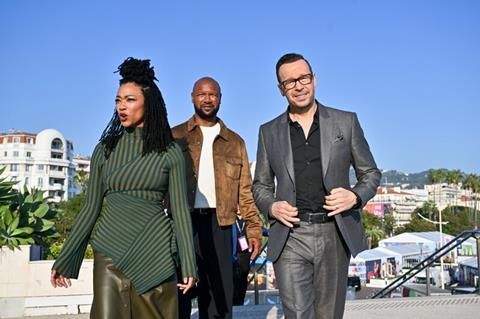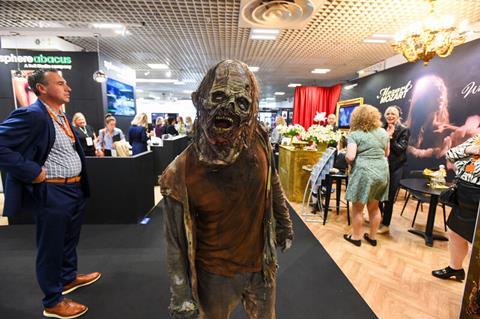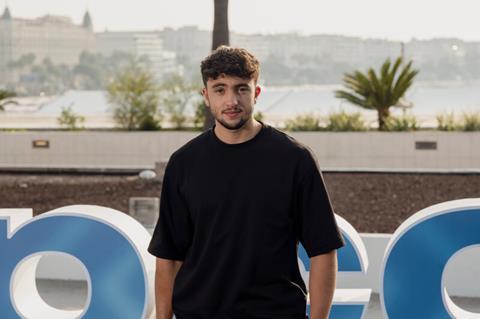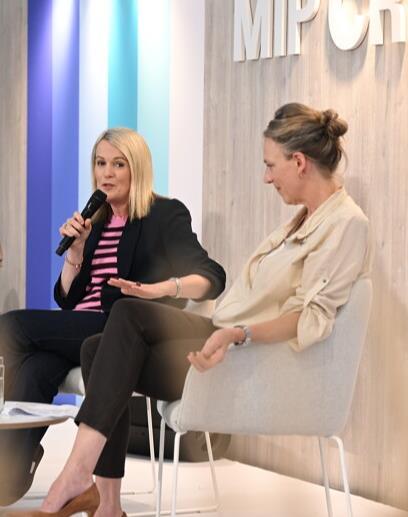Collaborations, M&A, vertical video, YouTube, rights and brands set to dominate global industry
It was a mixed ecology at Mipcom this year, with returning US studio giants such as Sony Pictures Television joining incumbent distributors, first-timers YouTube and zombies from The Walking Dead in Cannes.

The latter, not to be confused with those who had a couple too many in front of Brown Sugar the night before, were joined by stars of Paramount’s Boston Blue, while the creator economy got plenty of headlines.
But chatter along the Croisette was broad as industry incumbents plotted how to operate and survive in this fast evolving ecosystem with new partners and models emerging daily.
M&A chatter was at fever pitch - Paramount’s move for WBD and the future of ITV Studios among the main deals being discussed - while YouTube formats, scripted financing challenges and the rise of vertical video all created a buzzy market. But one word dominated above all else: collaboration.
Calling all collaborators
More partnerships look set to be a crucial part of the landscape going forwards, particularly for broadcasters and streamers. Channel 4 head of distribution and partnerships, Karla Berry, said the next five years would be defined by “transformation, resilience and collaboration” as the industry looks to sustain itself.

Speaking on a panel at an event by UK platform Freely, she said strategic partnerships “will be key for unlocking growth and reaching new audiences, and there are many ways in which businesses can partner together.”
She cited Freely as an example of a “unique collaboration between PSBs and other content providers, device platforms and operating systems” as well as her broadcaster’s recent partnership with UKTV to bring thousands of hours of the latter’s content to Channel 4 streaming next year.
“We’re the first UK public service streamer to carry a third-party service and that will really showcase the distinctiveness and the complementary nature of Channel 4 and UKTV content, and enable us to have better ad inventory,” she said.
“Whilst competition and plurality are incredibly important, there are lots of ways to be partnering together while maintaining our independence, whether that’s across tech, AI, metadata or compliance.”
Director of business development at AMC Networks, Lucy Halliday agreed that the future is about “ensuring we have got the right key partnerships”.
“The distribution partnerships and alliances we’ve done already are just the tip of the iceberg,” she added. “There are many more to come. SVoDs are plateauing in the UK, but AVoDs are growing, so we are competing on a wider market now. We have to do creative revenue deals that we wouldn’t have thought about three to five years ago.”
Pushing for partnerships
Some of the recent pacts struck by broadcasters and streamers are already shifting the way the industry operates.

Disney+ was in town to talk up how it is looking to work with broadcasters, with Nami Patel, senior vice-president of consumer strategy and business development, telling Broadcast International that her company wanted more broadcaster partnerships and would be flexible with deals.
Patel and Paolo Agostinelli, senior vice-president of affiliate and content distribution, discussed recent deals such as the pacts with ITVX in the UK and Atresplayer in Spain, adding that more deals are in the works to bring free-to-air content to the streamer – although it won’t affect local originals plans, which should be good news for producers across Europe.
Patel also revealed early findings from some of these partnerships including that recent drama launch Mare Afuera had been a Top 10 hit for both Atresplayer and Disney+ in Spain.
It suggests that audience segmentation may provide considerable opportunities and provides some context to TF1’s recent Netflix deal, struck partly to increase reach for the French broadcaster after it discovered a huge swathe of viewers were never leaving the US streamer’s service.
Rights in everyone’s sights
That latter deal in particular was a frequent source of debate among French producers, who are figuring out the implications on their own working practices.

But it was also a topic of conversation among the more internationally minded execs here in Cannes, who wonder whether the global streamer may strike other similar pacts in their countries.
The fear among some is that the mass transfer of all shows to Netflix will all but eradicate the value of domestic second windows. From talking to numerous French producers, it seems there was little to no warning about the deal given to them by either Netflix or TF1, but negotiations over rights are now top of mind for all.
Banijay France chief exec, Alexia Laroche-Joubert, told Broadcast International that one of her shows, Montmartre – a co-production between Disney+ and TF1 – will not be affected because the production deal was agreed first, but she admitted it is unclear what could happen on future series.
“We could face issues with our shows, we don’t have any answers yet,” she said. “The producer unions are speaking with TF1 on our behalf, there are some proposals that have been made that could see shows co-produced with streamers not being put into the slate of shows going to Netflix, but this is an ongoing conversation.
“TF1 is completely open to speak to our unions so we will see what will happen.”
Other producers voiced similar concerns, but few want to speak publically because Netflix is a potential client. However, the uncertainty caused by the deal is hampering productions, which rely on having a second window for financing. Several execs in Cannes told Broadcast International that the streamer-broadcaster deal is already causing delays and uncertainty that the industry can ill afford.
Tapping into YouTube
There was no escape from the Google-owned streamer, which took the fifth floor of the Palais and provided a plentiful source of conversation in Cannes.
While monetising existing content on the platform seems a relatively straightforward exercise, the ability of YouTube to breath life into original content from producers more used to TV budgets is unclear.
One sector of the industry beginning to find returns, however, are those creating unscripted formats. Some TV shows are being revived in partnership with YouTubers, while the latter are also creating new IP.

At The Wit’s Fresh TV Format presentation at Mipcom, co-founder Virginie Mouseler highlighted two such recent YouTube gameshow creations in France, which are more ambitious than usual and look more like traditional TV shows.
In Stop the Train, a 90-minute special that launched on YouTube last month, French star Squeezie hosts a competition featuring ten other YouTubers (with a combined 70m subscribers). They face physical, strategic, or psychological challenges in each carriage, with the loser being eliminated as their carriage detaches. The winner is the one who manages to reach the locomotive and stop the train, winning €100,000.
It was advertised as the most expensive YouTube show in France, with a €700k per-episode budget, said Mouseler, while the show garnered 12 million views in four weeks, “which is good, though not exceptional,” she said.
Another YouTube format was the four-episode series Terminal, a manhunt in an abandoned airport. It featured eight teams of two contestants, including Michou and Inoxtag (10m subscribers each), who had to survive 18 hours in a deserted airport. The €1m per-episode budget was part of the marketing, she said. The show accumulated 22 million views over four episodes in four weeks.
In the Netherlands, the RTL reality game Catch-Us if You Can, from Signal.Stream and Talpa Studio, was first piloted on YouTube before being produced as a bigger version. It features three celebrities who become living targets tracked across Europe by 12 others. Signal.Stream founder Wouter Van der Pauw explained in another Mipcom session that this approach helps reduce the risk, as it enables them to see how many people are watching, who they are (the audience profile), and fine-tune the format.
Conversely, some older TV formats are enjoying YouTube reboots. At the Frapa Format Summit, Richard Ager, head of legal business affairs at Fremantle, spoke about the company’s classic format Supermarket Sweep being revived for the platform in collaboration with YouTubers The Sidemen, who have 22 million subscribers.
“Some creators like to take on formats. It’s a great opportunity to work with them and develop an idea,” he said. Banijay France, meanwhile, launched a contest to find digital creators who could reimagine five of the group’s formats from different genres. Banijay will allocate €50,000 to each of the five winners to produce a pilot.
“It’s an experiment, so we don’t yet know what will follow,” said Banijay France’s Laroche-Joubert to a packed room. “If it’s a success, a season could follow, either for digital or jumping to TV. And if this scheme works, we will roll it out to other countries.”
“It’s more money than I’ve ever had to produce one of my YouTube shows,” commented digital creator Sparkdise, one of the winners.
Vying for vertical integration
Microdramas were barely known at Mipcom last year. Now, they are a source of fascination for some in the industry yet still something to ridicule for others.
What was apparent in Cannes is that senior executives, well-versed in flash-in-the-pan ideas that won’t go anywhere, are looking increasingly closely at both microdrama and more broadly the rise of vertical video.

Fox Entertainment chief Rob Wade spoke to Broadcast International about why his company sunk some of its investment pot into the genre (read more about that here), tempering over-exuberance with an open-mindedness about the genre.
“Coming from unscripted, sometimes it’s easy to create a narrative to look down on certain types of content. It is usually from a place of fear, it’s that this new thing might take on what I’m doing already.
“It is very easy to do that looking at microdramas, or an unscripted show - but the truth is that all content has value. And whether you like it or not [as a viewer] is neither here nor there. For the amount of money these shows are being made for I would challenge anybody else in Hollywood to try to do it better. This is a medium that if you want to be creative you can do great things.”
Disney’s Diego Londono also told Broadcast International about his “fascination” around vertical and shortform, with others such as All3Media International chief Louise Pedersen and Guillaume Pommier, co-head of distribution at Federation Studios in France, noting ”some interesting conversations” around the nascent content.
Next steps will be intriguing: Bogdan Nesvit, co-chief exec at Holywater, said he wanted to explore taking microdramas “to the next level” with Fox by tripling the roughly $150,000 budget for an 80-episode show.
Disney+ is considering adding a tile for microdramas to its service, as revealed by Broadcast International this week, and unscripted producers are also lining up to join the vertical video surge to meet younger viewers.
‘Brands are the new broadcasters’
Producers such as Zig Zag’s chief executive Danny Fenton also noted that digital brands had a bigger presence than ever before at the market.
“It was indicative of the state of the industry that so few producers and broadcast commissioners were present at Mipcom this year but in their place were YouTubers, creators and brand representatives,” he said.

“For the first time in the history of me visiting Cannes, it finally felt like brands were the new broadcasters – and some of them don’t even want to broadcast but wanted to commission for their own channels and networks,” he told Broadcast International.
But broadcasters are also leaning into the YouTube opportunity, with BBC and Channel 4 leaders each discussing their strategies. During her on-stage discussion of scripted content at the BBC, chief content officer Kate Phillips teased “new commissioning opportunities for bespoke commissioning for YouTube” and acknowledged that the platform is “rising”.
Channel 4’s Berry said that investing in social-first strands such as Channel 4.0 is bringing “fresh formats and new voices” to the Google platform and social media such as TikTok.
“There has been a lot of noise around us putting full episodes on YouTube and we have seen 60% growth year on year of full episode viewing, as well as our watch time on TikTok up 80% year on year.
“That viewing is incremental – it’s not cannibalising what we’re doing elsewhere. It’s about finding those audiences wherever they might be,” she added.
Freely chief exec Jonathan Thompson said YouTube is a “huge” part of the future of TV, but not the only part - reflecting growing conversations around the long-term impact of the platform on broadcasters.
“In the 2030s we are likely to move from a broadcast world to fully streaming world, and it’s important we take everyone on that journey so all viewers can benefit from that transition.
“I’m confident that doing it well is about protecting creative diversity, choice and the PSB system,” he said.









No comments yet